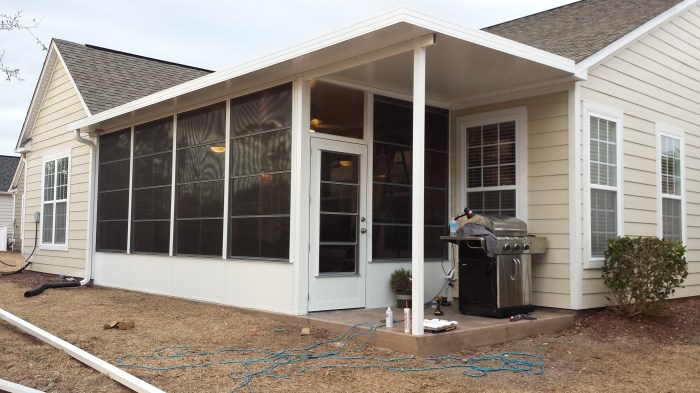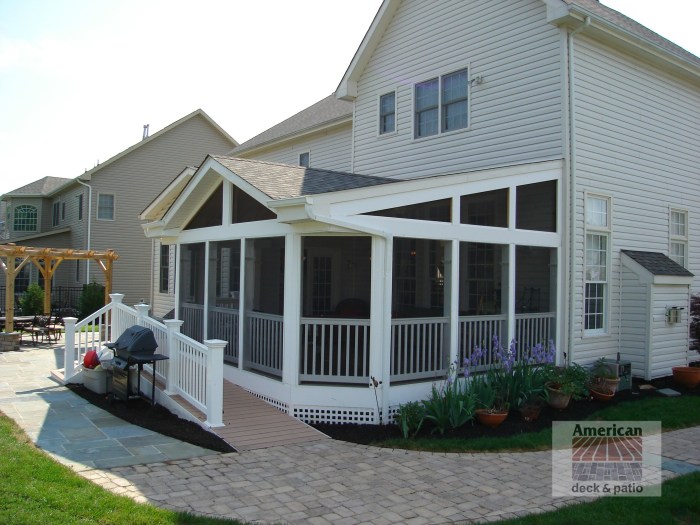Elevate your outdoor living experience with the captivating allure of patio screen enclosures. These versatile structures not only enhance the aesthetic appeal of your home but also provide a myriad of benefits, transforming your backyard into a tranquil haven.
Whether you seek refuge from insects, desire increased privacy, or simply wish to extend your living space, patio screen enclosures offer an array of customizable options to suit your unique needs and preferences.
Types of Patio Screen Enclosures
Patio screen enclosures are a great way to enjoy the outdoors without being bothered by insects or other pests. They can also provide shade from the sun and protect your furniture from the elements. There are many different types of patio screen enclosures available, so it’s important to do your research before making a decision.
Materials Used
The most common materials used for patio screen enclosures are aluminum, vinyl, and fiberglass. Aluminum is a lightweight and durable material that is resistant to rust and corrosion. Vinyl is also a durable material that is easy to clean and maintain.
Fiberglass is a lightweight and inexpensive material that is available in a variety of colors and styles.
Styles and Designs
Patio screen enclosures come in a variety of styles and designs. Some of the most popular styles include:
- Screened-in porches: These enclosures are typically attached to the side of a house and have a roof and walls made of screens.
- Screened-in gazebos: These enclosures are freestanding structures that have a roof and walls made of screens.
- Retractable screen enclosures: These enclosures can be opened and closed as needed, making them a great option for patios that are used for both indoor and outdoor activities.
Advantages and Disadvantages
Each type of patio screen enclosure has its own advantages and disadvantages. Aluminum enclosures are durable and resistant to rust and corrosion, but they can be more expensive than other types of enclosures. Vinyl enclosures are easy to clean and maintain, but they can be less durable than aluminum enclosures.
Fiberglass enclosures are lightweight and inexpensive, but they can be less durable than aluminum or vinyl enclosures.
Benefits of Patio Screen Enclosures
Patio screen enclosures offer numerous advantages that enhance outdoor living experiences and provide practical benefits for homeowners. These enclosures extend the functionality of patios, making them more enjoyable and comfortable throughout the year.
One significant benefit of patio screen enclosures is protection from insects. These enclosures act as a barrier against mosquitoes, flies, and other pests, allowing homeowners to enjoy their outdoor space without the annoyance or potential health risks associated with insect bites.
By keeping insects out, patio screen enclosures create a more pleasant and comfortable environment for relaxation, dining, and entertaining.
Increased Privacy
Patio screen enclosures also provide increased privacy for homeowners. They create a secluded outdoor space that is shielded from the view of neighbors or passersby. This allows homeowners to enjoy their patio without feeling exposed or self-conscious. Patio screen enclosures can also be customized with privacy screens or curtains to further enhance privacy and create a more intimate setting.
Extended Living Space
Patio screen enclosures effectively extend the living space of a home. They transform outdoor patios into usable areas that can be enjoyed during all seasons. By enclosing the patio, homeowners gain additional space for entertaining guests, relaxing, or simply enjoying the outdoors.
Patio screen enclosures can also be used as an extension of the home’s living room or dining room, creating a seamless transition between indoor and outdoor spaces.
Enhanced Outdoor Living Experiences
Patio screen enclosures enhance outdoor living experiences in various ways. They provide protection from the elements, such as rain, wind, and UV rays, allowing homeowners to enjoy their patio even during inclement weather. Additionally, patio screen enclosures can be equipped with fans or air conditioning units to create a more comfortable temperature-controlled environment.
Potential Impact on Property Value and Curb Appeal
Patio screen enclosures can have a positive impact on property value and curb appeal. They add an attractive and functional feature to the home, making it more desirable to potential buyers. Patio screen enclosures can also improve the overall appearance of a home, making it more inviting and appealing from the outside.
Design Considerations for Patio Screen Enclosures
When designing a patio screen enclosure, several factors should be considered to ensure it meets your needs and complements your outdoor space. The size and shape of the enclosure should be carefully planned to accommodate your desired seating and activity areas.
The location and orientation of the enclosure should also be considered to maximize natural light and ventilation while minimizing exposure to harsh weather conditions.
Choosing the Right Size and Shape
The size and shape of your patio screen enclosure will depend on the available space and the intended use. Consider the number of people you typically entertain, the size of your furniture, and any additional features you may want to include, such as a grill or hot tub.
The shape of the enclosure can be rectangular, square, or even curved to match the contours of your patio.
Location and Orientation
The location and orientation of your patio screen enclosure will impact its functionality and comfort. Choose a location that is protected from strong winds and direct sunlight during peak hours. Consider the direction of the prevailing wind to ensure proper ventilation.
The enclosure should also be positioned to take advantage of natural light while minimizing glare.
Design Elements
The design elements of your patio screen enclosure should complement the overall aesthetic of your outdoor space. The placement of doors and windows should allow for easy access and cross-ventilation. Consider adding skylights or solar tubes to provide natural light.
Lighting fixtures can be used to create a cozy ambiance in the evening.
Installation and Maintenance of Patio Screen Enclosures
Installing a patio screen enclosure enhances your outdoor living space, offering protection from insects, sun, and debris. The installation process involves several steps, and proper maintenance ensures the enclosure’s longevity.
Installation Process
| Step | Description |
|---|---|
| 1 | Measure the patio area and determine the enclosure’s dimensions. |
| 2 | Assemble the frame using the provided brackets and screws. |
| 3 | Install the base plates and secure the frame to the patio. |
| 4 | Attach the screen panels to the frame using spline or other fastening methods. |
| 5 | Trim any excess screen material and seal the edges for a snug fit. |
Maintenance Tips
Regular maintenance extends the life of your patio screen enclosure:
- Clean the screens periodically using a soft brush or vacuum cleaner.
- Inspect the frame and screen for any damage or loose connections, and repair them promptly.
- Avoid using harsh chemicals or abrasive cleaners on the enclosure.
- Keep the area around the enclosure clear of debris and vegetation to prevent damage.
Potential Challenges and Considerations
During installation and maintenance, certain challenges may arise:
- Wind resistance: Ensure the enclosure is properly anchored to withstand high winds.
- Screen damage: Avoid sharp objects or excessive force when cleaning the screens.
- Seasonal changes: Prepare the enclosure for extreme weather conditions, such as heavy snowfall or hurricanes.
By following these guidelines, you can enjoy a well-maintained patio screen enclosure that provides years of outdoor enjoyment.
Cost and Value of Patio Screen Enclosures
Installing a patio screen enclosure can significantly enhance the value and enjoyment of your outdoor space. The cost of the enclosure will vary depending on several factors, including the size, materials, and labor required.
On average, the cost of a patio screen enclosure can range from $5,000 to $20,000 or more. Smaller enclosures with basic materials will typically cost less, while larger enclosures with premium materials and custom features will be more expensive.
Factors Influencing Cost
- Size: Larger enclosures require more materials and labor, increasing the overall cost.
- Materials: The type of screening material (e.g., fiberglass, aluminum, or vinyl) and frame materials (e.g., aluminum or wood) can impact the cost.
- Labor: The complexity of the installation and the availability of skilled labor in your area can affect the labor costs.
Potential Return on Investment
While the cost of a patio screen enclosure can be substantial, it can also provide a significant return on investment. Enclosures can increase the value of your home, extend the usability of your outdoor space, and reduce energy costs by providing shade and insulation.
Value-Added Benefits
- Increased Comfort: Enclosures protect against insects, UV rays, and inclement weather, making your patio more comfortable to enjoy.
- Enhanced Privacy: Screens provide privacy from neighbors and passersby, creating a more secluded outdoor oasis.
- Extended Living Space: Enclosures allow you to use your patio for longer periods during the year, even in unfavorable weather conditions.
Creative Ideas for Patio Screen Enclosures
Patio screen enclosures offer a fantastic opportunity to transform your outdoor space into a stylish and functional retreat. With a little creativity, you can turn your enclosure into a personalized oasis that reflects your taste and lifestyle. Here are some innovative ideas to inspire you:
Incorporate Plants: Lush greenery adds life and vibrancy to any space. Hang plants from the ceiling, place them on shelves, or create a vertical garden. Choose plants that thrive in the shade or partial shade, such as ferns, succulents, or philodendrons.
Furniture
Patio furniture is essential for creating a comfortable and inviting space. Opt for weather-resistant materials like wicker, resin, or aluminum. Choose furniture in colors and styles that complement your enclosure’s decor. Consider adding a lounge area with cozy seating and throw pillows.
Lighting
Lighting plays a crucial role in creating ambiance and extending the use of your enclosure into the evening. String lights, lanterns, or recessed lighting can provide soft illumination. For a touch of drama, install outdoor spotlights to highlight specific features, such as plants or architectural details.
Trends and Emerging Styles
The latest trends in patio screen enclosure design include:
- Integrated Pergolas: Pergolas provide shade and add architectural interest. Consider adding a pergola with climbing plants or hanging lights.
- Retractable Screens: Retractable screens allow you to control the amount of sunlight and ventilation in your enclosure.
- Natural Materials: Incorporate natural materials like wood, stone, or bamboo into your enclosure’s design for a rustic and inviting look.
Last Point
From selecting the perfect materials and design to ensuring proper installation and maintenance, the possibilities are endless when it comes to creating your dream patio screen enclosure. Embrace the opportunity to enhance your outdoor sanctuary, adding value to your home while creating cherished memories in a space that seamlessly blends comfort, style, and functionality.



